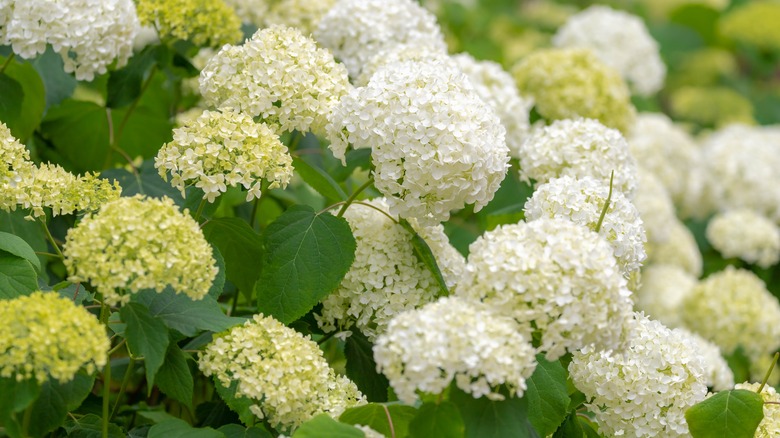Hydrangeas have become a landscape staple because of their colorful, vibrant, and showy blossoms. While most hydrangeas are easy to care for, some varieties prefer more pruning than others to grow larger flowers — Annabelle hydrangeas (Hydrangea arborescens ‘Annabelle’) are a case in point. When left unpruned, these glorious shrubs bloom beautifully, albeit at the cost of developing smaller flowers, which works if it suits your preferences. However, you can gain greater benefits by trimming them regularly.
Pruning hydrangea flower heads before the growth season ends can promote another spurt of flower blossoms in some cultivars. Moreover, it helps maintain the hardy shrub’s visual appeal by reshaping the plant and managing its size. But the biggest gain lies in its ability to sprout thicker, sturdier stems, supporting an even bigger snowball-sized white flower growth. Given their propensity to grow flowers only on new wood, it’s ideal to trim these deciduous plants toward the end of winter or early spring, right before new buds emerge.
About Annabelle hydrangeas

Belonging to the smooth hydrangea variety, Annabelle hydrangeas are prized for their attractive, big white flower clusters that closely resemble a snowball and have a spread that measures up to 30 centimeters. Hardy in zones 3 to 9, these shrubs easily adapt to full or partial sun conditions, making them popular amongst amateur green enthusiasts. They initially develop green puffs, which slowly mature into white blooms. Their alluring flowers remain in full bloom for over 6 to 8 weeks, eventually turning lime green when summer ends.
During the fall, Annabelle hydrangeas take on a tan hue, which causes many gardeners to delay their pruning until late winter to retain visual interest. Unlike other hydrangea varieties, Annabelle solely supports sterile flower heads whose color remains unchanged regardless of the soil pH level. They grow elliptical, long-petioled, green leaves, which turn goldish-yellow and drop down when the plant goes dormant during the winter. As these hardy shrubs thrive, with many expanding to 6 to 8 feet at maturity, it’s essential to prune them regularly to control their spread and avoid any damage to new bud growth.
How to prune Annabelle hydrangeas

YouTube
As some Annabelle cultivars can produce an additional flower flush, many prefer trimming the plant when its flowers fade during the summer end or early fall. However, to promote bigger blooms, it’s ideal to prune the shrub in late winter or early in the spring before new leaves grow out. Cutting down the shrub’s old stems to around 4 to 6 inches in height promotes large flowers in the next season, but it may turn the plant droopy. So, to retain a taller and sturdier growth, you can prune it to around 18 to 24 inches from the ground.
The first step to pruning Annabelle Hydrangeas is to remove discolored flowers and damaged stems during the fall. Also, remove all plant branches crossing each other or growing horizontally to prevent wound rubbing and maintain a tall structure. Pare down around ⅓ of the plant’s oldest stems to the healthiest bud growth during late winter to instill new growth. You can even use this dormancy to give the plant a different shape by making cuts on the plant’s crown.



